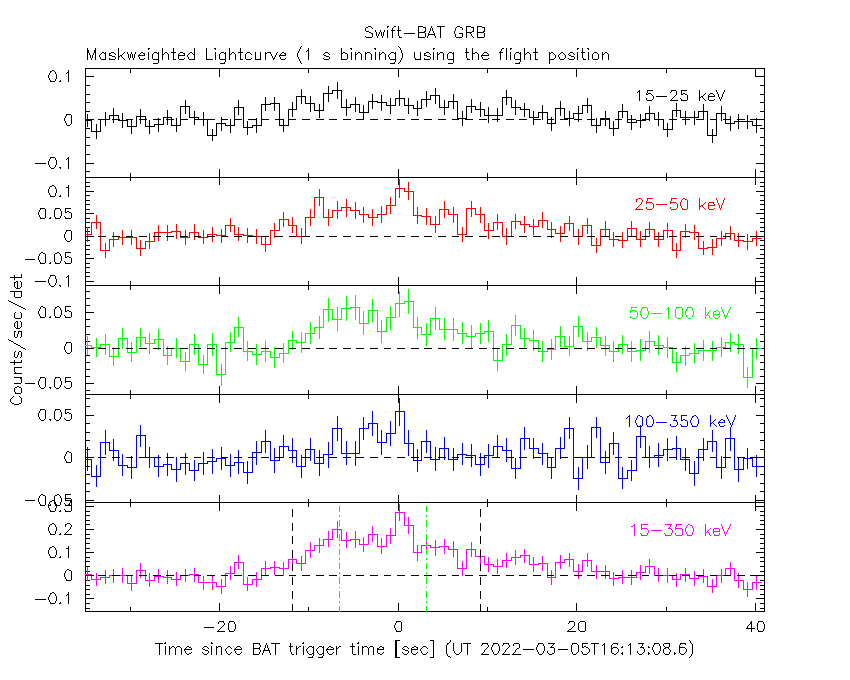
R. Caputo (GSFC) and V. D'Elia (SSDC and INAF-OAR) for the Swift team
At 16:13:08 UT, the Swift Burst Alert Telescope (BAT) triggered and located GRB 220305A (trigger=1095215) (Caputo et al. GCN Circ. 31684). Due to a viewing constraint, Swift did not immediately slew. At the time of the trigger, the initial BAT position was 110° from the Sun (8.1 hours East) and 91° from the 10%-illuminated Moon. Table 1 contains the best reported positions from Swift, and the latest XRT position can be viewed at http://www.swift.ac.uk/xrt_positions.
Table 2 is a summary of GCN Circulars about this GRB from observatories other than Swift.
Standard analysis products for this burst are available at https://gcn.gsfc.nasa.gov/swift_gnd_ana.html.
As reported by Stamatikos et al. (GCN Circ. 31698),
the BAT ground-calculated position is RA, Dec = 107.610, -37.703 deg which is RA(J2000) = 0
The mask-weighted light curve (Figure 1) shows a single-pulse structure that starts at ~T-15 s, peaks at ~
The time-averaged spectrum from T-15.04 to T+11.02 s is best fit by a simple power-law model.
The power law index of the time-averaged spectrum is 1.66 ± 0.15.
The fluence in the 15-150 keV band is 2.0 ± 0.2 x 1
The results of the batgrbproduct analysis are available at https://gcn.gsfc.nasa.gov/notices_s/1095215/BA/.
Analysis of the initial XRT data was reported by D'Elia et al. (GCN Circ. 31695). We have analysed 11 ks of XRT data for GRB 220305A, from 3.0 ks to 78.5 ks after the BAT trigger. The data are entirely in Photon Counting (PC) mode. The enhanced XRT position for this burst was given by Beardmore et al. (GCN Circ. 31688).
The light curve (Figure 2) can be modelled with a power-law decay with a decay index of α=1.14 ± 0.08.
A spectrum formed from the PC mode data can be fitted with an absorbed power-law with a photon spectral index of 2.30 (+0.26, -0.24). The best-fitting absorption column is 7.7 (+1.8, -1.6) x 1
A summary of the PC-mode spectrum is thus:
Total column: 7.7 (+1.8, -1.6) x 1
Galactic foreground: 2.6 x 1
Excess significance: 5.3 σ
Photon index: 2.30 (+0.26, -0.24)
The results of the XRT team automatic analysis are available at http://www.swift.ac.uk/xrt_products/01095215.
UVOT results are not available.

Figure 1. The BAT
mask-weighted light curve in the four individual and total
energy bands. The units are counts

Figure 2. The XRT light curve.
Any data from a crosshatched region are not included in the fit.
| RA (J2000) | Dec (J2000) | Error | Note | Reference |
|---|---|---|---|---|
| 0 |
-37°40'49.2" | 2.0" | XRT-final | UKSSDC |
| 0 |
-37°40'49.2" | 2.2" | XRT-enhanced | Beardmore et al. GCN Circ. 31688 |
| 0 |
-37°42'09.2" | 1.5' | BAT-refined | Stamatikos et al. GCN Circ. 31698 |
| Band | Authors | GCN Circ. | Subject | Observatory | Notes |
|---|---|---|---|---|---|
| Optical | Lipunov et al. | 31686 | Swift GRB 220305A: Global MASTER-Net observations report |
MASTER | |
| Optical | Lipunov et al. | 31691 | Fermi GRB 220305A: Global MASTER-Net observations report |
MASTER | |
| Gamma-ray | Dunwoody et al. | 31689 | Fermi GBM observation | Fermi GBM | Fluence=6.8±0.8x1 (brighter than 8% of long GRBs) |
| Gamma-ray | Dunwoody et al. | 31690 | Correction to GCN Circ. 31689: Fermi GBM Report of GRB 220305A should be GRB 220305B |
Fermi GBM | Fluence=6.8±0.8x1 (brighter than 8% of long GRBs) |
| Gamma-ray | Wood | 31696 | Fermi GBM Sub-Threshold Detection | Fermi GBM |
March 7, 2022